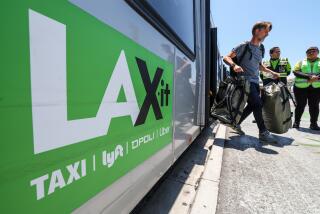Foothill Transit Adds 2 Buses to Ease Crowding
- Share via
The price seems to be right for the more than 2,600 San Gabriel Valley bus riders using the Foothill Transit Zone’s two daily commuter express lines.
What’s wrong, and what zone officials are worried about, is that the same low fares that have attracted new riders have also left many people standing during the 45-minute ride to downtown Los Angeles.
“We’re very pleased that it was overcrowded,” said Foothill Vice President Judy Wright, who also acknowledged that the standing-room-only conditions may not be ideal from the rider’s standpoint.
“That’s why we wanted to respond to it immediately,” she said. “We want (the ride) to be as comfortable as possible.”
The zone’s executive board, made up of the mayors of four cities and a county representative, has authorized putting two spare buses into service on park-and-ride routes 495 and 498, which originate in the eastern San Gabriel Valley. The extra buses, which will bring the operating fleet up to 24, are scheduled to begin service next week.
Foothill Transit, formed by 20 San Gabriel Valley cities and the county, is intended to be a low-cost alternative to the RTD in the area. The transit zone contracts with private bus companies to provide service.
In December, the Southern California Rapid Transit District agreed to transfer 14 routes to Foothill Transit over a two-year period, ending a dispute between the RTD and Los Angeles County Transportation Commission that had prevented Foothill Transit from operating. Foothill now operates only the two express lines but is scheduled to pick up six local lines by mid-summer.
The commission approved the zone’s start-up in December, 1987, but implementation was blocked by legal challenges by the RTD and its drivers and mechanics unions. In the December agreement, the RTD dropped its opposition.
Still to be resolved is the challenge by the unions. The suit, which claims that the “privatized” system threatens union jobs, will be heard in Los Angeles Superior Court on April 10.
Increase in Ridership
In 1986, the RTD served a weekday average of 2,664 riders on routes 495 and 498, said William P. Forsythe, Foothill’s interim executive director. Since taking over the lines, the zone, which charges $10 less than RTD had charged for a monthly pass, has seen a marked increase in ridership, Forsythe said, although the agency does not yet have exact numbers.
On most days, when the buses reach their last local stops, each of the 43 seats are taken and more than a dozen people jam the aisles, Forsythe said. The coaches carry a maximum of 60 people.
Foothill President Don McMillen acknowledged that the agency’s image could be hurt if riders got the impression that it gave cheap, but uncomfortable, rides.
McMillen credited the cheaper fares and brand-new buses with attracting the increased ridership.
“That’s a big factor,” he said. “If you’re going to save 50 cents a day, for a lot of people that adds up. Plus, our buses are pretty nice.”
Despite the specter of the April legal challenge, Foothill officials plan to purchase buses for the next routes to be transferred from the RTD. The six local lines, to be transferred around July, will double the number of Foothill buses operating.
‘Moving Right Along’
“We still have got to have a favorable decision,” McMillen said. “But the way it stands now, it kind of looks like we’re moving right along.”
The bid packages from the bus companies for the new lines will be presented at the February meeting of Foothill Transit’s five-member executive board.
At the same meeting, Foothill directors are expected to make decisions on two housekeeping matters: permanent office space for the zone and the hiring of management staff.
Claremont Mayor Wright said the decision on office space would likely be made sometime this week, with sites in West Covina and El Monte under consideration.
For management, board members have indicated a preference for staying with zone architect Forsythe and his company, Forsythe and Associates Inc., as the first management firm to oversee operations.
More to Read
Sign up for Essential California
The most important California stories and recommendations in your inbox every morning.
You may occasionally receive promotional content from the Los Angeles Times.













